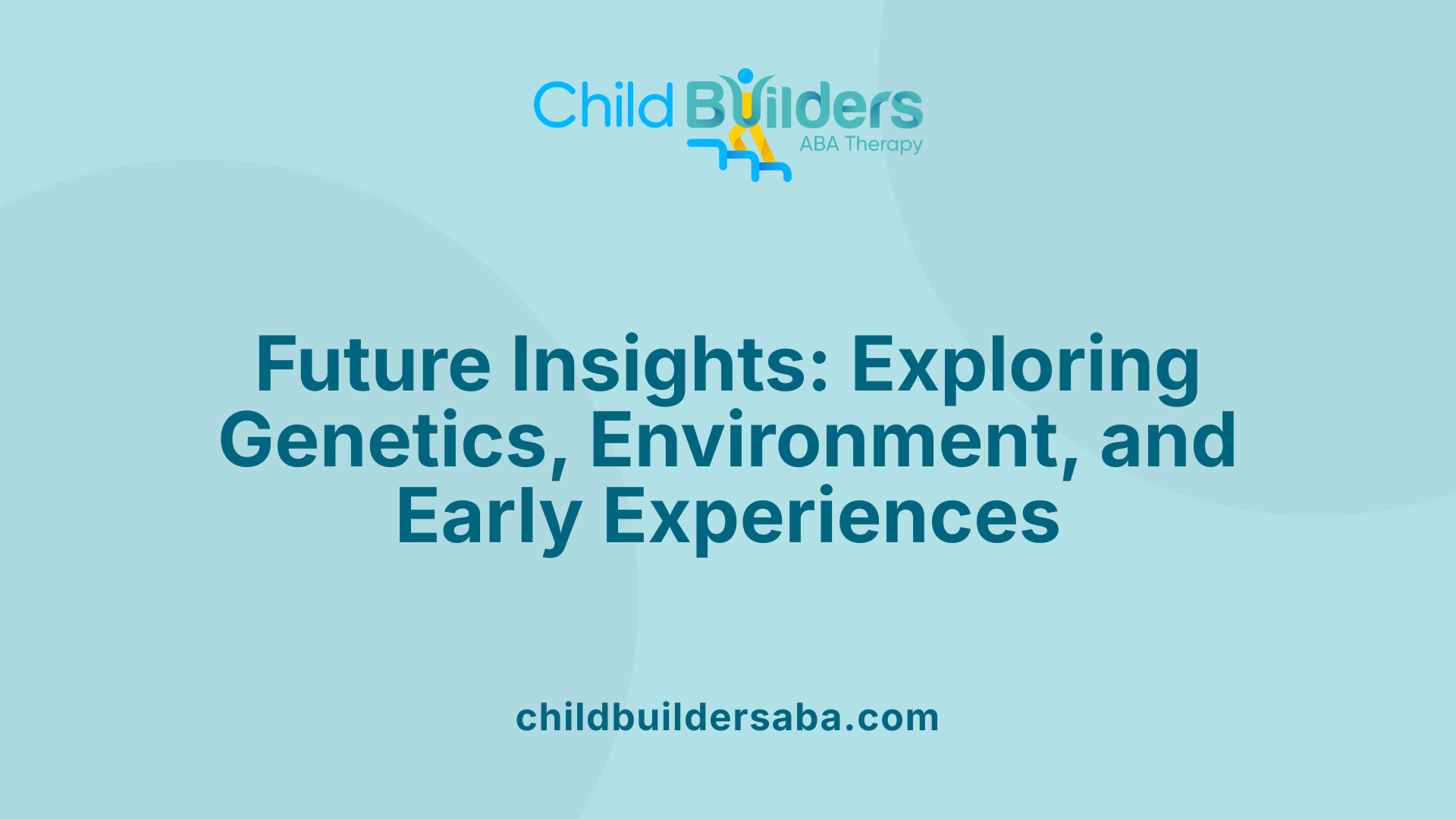Does Emotional Neglect Cause Autism?

Debunking Misconceptions and Presenting Evidence-Based Insights
The question of whether emotional neglect causes autism spectrum disorder (ASD) is a common concern among parents, educators, and mental health professionals. This article explores the scientific understanding of autism’s origins, clarifies misconceptions about emotional neglect, and discusses how environmental and genetic factors interplay in its development. By examining recent research, we aim to provide clear, accurate information to foster better awareness and reduce stigma surrounding autism.
Historical Perspectives and Evolving Scientific Understanding

How did misconceptions about autism and parenting develop?
Historically, misconceptions about the causes of autism often linked parenting styles, especially emotional neglect or cold parenting, to the development of autism spectrum disorder (ASD). One of the most prominent false theories was the 'refrigerator mother' hypothesis, proposed in the mid-20th century. This theory wrongly suggested that mothers who were cold, unaffectionate, or distant caused autism in their children.
What has research shown about these outdated theories?
Over the decades, extensive scientific research has thoroughly debunked these ideas. Studies consistently show that autism is primarily rooted in genetics and neurodevelopmental processes. Environmental factors, such as prenatal conditions or exposure to certain substances, play a secondary role. Importantly, autism symptoms are present early in life, often before significant parenting influences come into play, indicating that parenting style does not cause autism.
What is the current scientific understanding of autism causes?
Today, the consensus among experts is that autism arises from complex interactions of genetic factors and brain development. Genetic studies have identified numerous associated genes, and neuroimaging reveals atypical brain growth and connectivity. While environmental factors can influence severity or co-occurring conditions, they are not the root causes. This advancing knowledge has shifted the focus away from blaming parents, emphasizing instead early diagnosis and supportive therapies.
Why is it important to dispel misconceptions?
Understanding the true origins of autism helps combat stigma and supports affected individuals and families. It fosters more empathetic attitudes and directs resources toward scientific research and effective interventions. Clearing up misinformation about parenting and autism encourages a more accurate, respectful view of neurodiversity.
Genetic and Neurobiological Foundations of Autism

Does childhood emotional neglect influence the development of autism?
Research indicates that childhood emotional neglect, while impactful on various aspects of emotional and social development, does not cause autism spectrum disorder (ASD). The primary contributors to autism are believed to be genetic and neurobiological factors.
Studies on the genetic basis of autism have identified multiple gene mutations and variations that are associated with the disorder. These genetic factors influence brain development and function, leading to the characteristic behaviors and challenges seen in individuals with ASD. Neurodevelopmental research shows that abnormalities in brain structure and connectivity also play significant roles.
While emotional neglect can worsen social skills and emotional regulation, it does not initiate the neurodevelopmental pathways associated with autism. Instead, children with autism are often at a higher risk of experiencing maltreatment, including neglect, which can intensify difficulties but does not serve as a root cause.
In summary, autism results from complex genetic and neurobiological mechanisms. Childhood emotional neglect, although impactful on mental health, social functioning, and emotional well-being, is not linked as a cause of autism.
Additional Insights on Autism's Foundations
| Aspect | Description | Related Research |
|---|---|---|
| Genetic Factors | Multiple gene mutations linked to autism | Genetic studies, twin research |
| Neurobiological Features | Brain structure and connectivity differences | Neuroimaging studies |
| Environmental Factors | Less direct, including prenatal conditions | Birth complications, exposure to toxins |
Understanding the roots of autism helps clarify that while maltreatment can worsen various outcomes, the disorder's basis lies mainly in genetic and neurodevelopmental domains. Ongoing research continues to search for the precise mechanisms behind autism, aiming to improve diagnosis and tailored interventions.
Environmental Factors and Their Role in Autism Development
What complex factors are involved in the development of autism regarding emotional neglect?
The development of autism spectrum disorder (ASD) involves a multifaceted interplay of genetic and environmental factors. While emotional neglect and other forms of childhood maltreatment can influence a child's emotional and social development, they are not identified as direct causes of autism.
Research highlights that genetic components play a significant role in autism risk. Specific gene mutations, copy number variations, and inherited genetic patterns are associated with increased susceptibility. Notable gene regions implicated include 15q11−15q13, 16p11, and 11q13. These genetic factors set the foundational neurodevelopmental architecture that can predispose individuals to autism.
In addition to genetics, environmental influences during prenatal and early postnatal periods are crucial. Factors such as advanced parental age, prenatal exposure to toxins like pesticides or medications, maternal health issues—including gestational diabetes and preeclampsia—and birth complications like preterm birth can elevate autism risk.
Importantly, these environmental exposures often interact with genetic predispositions, amplifying their effects. For instance, a child with certain genetic markers may be more vulnerable when exposed to specific environmental risks during critical periods of brain development.
While emotional neglect and adverse childhood experiences can adversely affect a child's emotional, social, and mental health—contributing to conditions such as depression—they are not central causes of autism. Instead, autism primarily arises from underlying neurobiological differences, with environmental factors acting as modifiers rather than direct instigators.
Understanding autism development requires a comprehensive view that considers both biological predispositions and environmental exposures during sensitive developmental windows. Ongoing research continues to explore these complex gene-environment interactions to better identify risk factors and potential intervention points.
| Factors | Description | Impact on autism risk |
|---|---|---|
| Genetic mutations and variations | Rare gene mutations, copy number changes, inherited patterns | Primary contributions to susceptibility |
| Prenatal exposures | Toxins, maternal health issues, advanced parental age | Alter neurodevelopmental trajectories |
| Birth and perinatal factors | Premature birth, birth complications, preeclampsia | Potential influence but smaller role |
| Childhood maltreatment | Emotional neglect, abuse (impacting emotional health) | Not direct causes but affect mental health |
Exploring the interaction between these factors helps to better understand autism's complex origins and guide research toward more effective preventive and therapeutic strategies.
The Impact of Adverse Childhood Experiences (ACEs) on Neurodevelopment and Mental Health
What does scientific research say about a potential link between emotional neglect and autism?
Research indicates that autism spectrum disorder (ASD) is primarily driven by genetic and neurobiological factors. Current scientific evidence does not establish emotional neglect or other adverse childhood experiences (ACEs) as direct causes of autism. Instead, autism is understood to originate from inherent neurodevelopmental differences.
However, it is crucial to recognize that individuals with autism are often more susceptible to ACEs such as emotional neglect, maltreatment, and bullying. These adverse experiences are linked to worse mental health outcomes and can influence developmental trajectories.
Studies have shown that ACEs, especially emotional neglect, are strongly associated with increased risks of depression, anxiety, and behavioral issues across various populations, including those with ASD. For example, neuroimaging and animal models suggest that stress and neglect during sensitive developmental periods can intensify ASD-like behaviors and brain differences, highlighting the importance of trauma-informed care.
While emotional neglect does not cause autism, it significantly impacts the mental health and neurodevelopment of affected individuals. Addressing trauma and providing supportive interventions can help mitigate long-term psychological challenges, improving quality of life for those on the spectrum.
| Aspect | Findings | Notes |
|---|---|---|
| Autism causes | Genetic and neurobiological | No current evidence for ACEs as direct causes |
| ACEs in autistic individuals | Common | Include emotional neglect and bullying |
| Impact of ACEs | Increased depression, anxiety | Related to trauma during development |
| Neuroimaging & animal studies | Stress worsens behaviors | Highlights importance of trauma management |
Overall, understanding the nuanced relationship between ACEs and neurodevelopment helps improve care strategies, emphasizing that while ACEs do not cause autism, they can influence mental health and behavioral outcomes.
Distinguishing Between Cause and Effect in Autism and Childhood Neglect
The relationship between childhood neglect and autism spectrum disorder (ASD) involves complex questions about causality and influence.
Recent research indicates that maternal exposure to childhood abuse significantly increases the risk of autism in offspring, with risk ratios ranging from about 3.0 to 3.7. This denotes a substantially elevated likelihood, yet it does not necessarily prove that neglect or abuse directly causes autism. Instead, these findings suggest a correlation where higher levels of abuse are associated with increased autism risk. Indeed, women exposed to the highest levels of childhood abuse had an autism prevalence of 1.8% in their children, compared to 0.7% among non-abused women.
However, when exploring whether childhood neglect or abuse is a direct cause of autism, evidence points to a more nuanced picture. While adverse perinatal factors, such as gestational diabetes and preeclampsia, are more common among women who experienced childhood abuse, they account for only about 7% of the increased autism risk. This indicates that other mechanisms, potentially genetic or epigenetic, play a more prominent role.
Specifically, emotional neglect and physical neglect emerge as strong predictors of depression, yet they do not fully explain the observed links between childhood maltreatment and high autistic traits. Although neglect influences certain mental health outcomes, it does not appear to directly cause autism, which is largely considered a neurodevelopmental condition with a substantial genetic basis.
Historical misconceptions once linked maternal neglect to autism, suggesting it as a causative factor. However, scientific consensus since the 1960s has shifted away from this view. Current understanding emphasizes that autism’s roots are primarily in genetic and neurobiological factors, with environmental influences like emotional neglect acting more as modulators or mediators of severity rather than direct causes.
In essence, while emotional neglect and other adverse childhood experiences can influence neurodevelopmental outcomes and mental health, they are not viewed as primary causes of autism. Instead, these environmental factors may interact with genetic predispositions, shaping the presentation and severity of ASD rather than initiating its development.
More Information Search Query: Cause versus consequence in autism, role of environmental factors in neurodevelopment.
The Role of Stress and Trauma in Exacerbating Autism-Related Behaviors

How neglect and trauma impact autistic individuals
Research shows that although autism spectrum disorder (ASD) primarily stems from genetic and neurobiological factors, experiences of trauma and neglect can significantly influence the well-being of autistic individuals. Children who face adverse experiences like emotional neglect, physical neglect, or abuse often develop additional mental health challenges, such as depression, anxiety, and behavioral difficulties.
Studies involving diverse populations reveal that autistic individuals are more likely than neurotypical peers to encounter adverse childhood experiences (ACEs). For example, research on college students in China found positive correlations between childhood neglect and traits like schizotypal personality and depression. Furthermore, emotional and physical neglect were the strongest predictors of depression among various forms of childhood maltreatment.
While childhood neglect did not directly explain the relationship between autistic personality traits and depression, it played a mediating role in connecting schizotypal traits with depressive symptoms. This suggests that trauma during formative years impacts neurodevelopmental and psychological pathways, potentially intensifying behavioral issues seen in autism.
Animal studies and neuroimaging research support this understanding by showing that stress and neglect during critical periods of brain development can worsen ASD-related behaviors. Stressors during sensitive phases may alter neural circuitry, making symptoms more pronounced or complicated.
In summary, although emotional neglect and trauma do not cause autism, they can aggravate its symptoms and influence long-term mental health outcomes. Addressing these traumatic experiences is crucial for improving support and intervention strategies for autistic individuals.
Additional Context and Future Directions in Autism Research
 Understanding the complex relationships between early life experiences and autism spectrum disorder (ASD) remains a focal point for ongoing research. Recent studies highlight a significant association between maternal childhood abuse and an increased risk of autism in offspring. Specifically, the risk ratio ranges from about 3.0 to 3.7, illustrating a notable connection.
Understanding the complex relationships between early life experiences and autism spectrum disorder (ASD) remains a focal point for ongoing research. Recent studies highlight a significant association between maternal childhood abuse and an increased risk of autism in offspring. Specifically, the risk ratio ranges from about 3.0 to 3.7, illustrating a notable connection.
The risk appears to escalate with higher levels of maternal abuse. Data shows that women who endured the most severe abuse in childhood have an autism prevalence rate of approximately 1.8% among their children. In contrast, women without such adverse histories exhibit a lower rate of around 0.7%. This monotonic trend suggests that greater exposure to childhood trauma correlates with increased autism risk, though it does not imply direct causality.
Additional factors come into play, such as adverse perinatal conditions—including gestational diabetes, preeclampsia, smoking during pregnancy, previous abortions, and preterm birth. These issues are more common among women who experienced childhood abuse. However, they only account for about 7% of the increased autism risk, indicating that other mechanisms likely contribute.
Researchers are exploring how childhood maltreatment influences developmental pathways beyond biological factors. A recent study involving college students in China examined how childhood neglect interacts with personality traits and depression. The findings showed positive correlations between autistic and schizotypal traits with childhood neglect and depression.
Particularly, emotional and physical neglect were identified as the strongest predictors of depression among different maltreatment types. Interestingly, childhood neglect did not directly explain the relationship between autistic or schizotypal traits and depression in the broader analysis. Instead, neglect mediated the link between schizotypal traits and depression, suggesting that neglect influences some pathways of mental health outcomes.
Despite these insights, the relationship between emotional neglect and autism itself remains unestablished. There is no evidence indicating a direct causal connection. Autism spectrum disorder is regarded primarily as a neurodevelopmental condition driven by genetic and biological factors. Children with ASD often experience adverse childhood experiences, such as emotional abuse, neglect, or bullying. These experiences can impact their emotional and social development, potentially mimicking symptoms associated with trauma-related disorders.
While trauma and neglect can influence overall development, they are not considered causes of autism. The current focus in autism research continues to prioritize understanding its neurobiological roots. Nonetheless, recognizing the impact of early adverse experiences is crucial, as they can complicate developmental trajectories and influence responses to intervention.
Looking ahead, future studies aim to dissect the intricate pathways linking early experiences, genetic predispositions, and neurodevelopmental processes. These research efforts may lead to improved strategies for early detection, intervention, and support for individuals across the autism spectrum, especially those affected by early trauma.
| Topic | Insights | Future directions |
|---|---|---|
| Maternal childhood abuse | Increases autism risk in children (RR 3.0-3.7) | Investigating mechanisms beyond biological factors |
| Perinatal factors | Some association but account for ~7% risk | Exploring other biological and environmental influences |
| Childhood neglect and personality | Linked to depression and personality traits; mediates some pathways | Delving into psychological pathways and intervention points |
| Emotional neglect and autism | No direct causal evidence; primarily influences development via other factors | Continuing research on neurodevelopmental and social factors |
Summary and Final Insights
In summary, extensive scientific research has firmly established that autism spectrum disorder primarily results from complex genetic and neurobiological factors. While adverse childhood experiences, including emotional neglect, can significantly impact the mental health and emotional development of individuals with autism, they are not considered causal factors for the condition itself. Addressing trauma and providing supportive interventions are crucial for improving quality of life for autistic individuals. Understanding autism as a neurodevelopmental disorder rooted in biology helps dispel harmful misconceptions, reduces stigma, and promotes more accurate, compassionate support for those affected.
References
- Maternal exposure to childhood abuse is associated with elevated ...
- The mediating effects of childhood neglect on the association ...
- Autism Spotlight | Learn Science at Scitable - Nature
- Impacts of adverse childhood experiences on individuals with ...
- The mediating effects of childhood neglect on the association ...
- Autism and Trauma: Research Updates
- Adverse Childhood Experiences in Children with Autism Spectrum ...





































































































